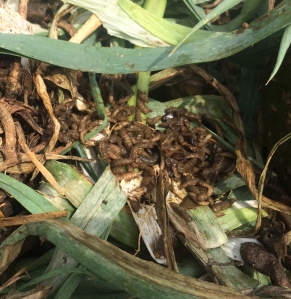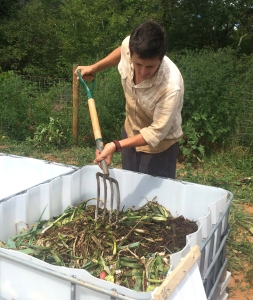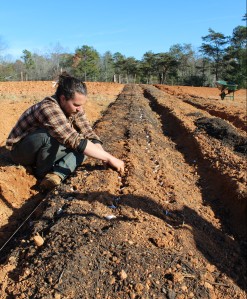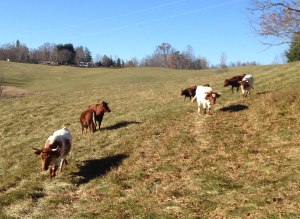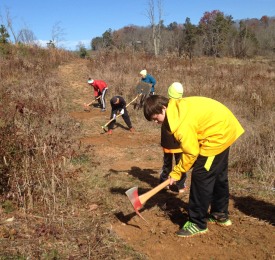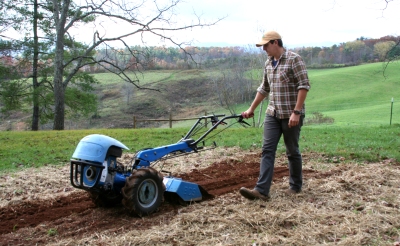
SAHC Community Farm and Food Program Associate, Chris Link, demonstrates the ease of steering the two-wheel tractor.
Why choose a two-wheel tractor for your home garden or small farmstead, instead of a standard four-wheel tractor or tiller?
This small but mighty tractor is a versatile investment. With over forty implements available, it is designed to be an all-in-one performer for hobby farms, market gardeners, and backyard homesteaders alike. It is a favorite around the world, known for comparative ease of maintenance and operation, with a lower initial price that puts it within reach of beginning and small-scale growers.
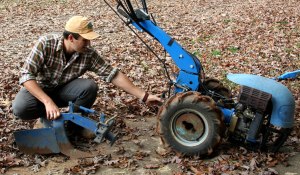
Chris explains how to connect various attachments which make the two-wheel tractor a versatile and efficient tool for small farms.
“The two-wheel tractor is just right for many operations — not too big and not too small,” said Community Farm & Food Program Associate Chris Link. “They are also particularly nimble and user-friendly on our hillsides and small pathways, and therefore, more efficient when you are working with a compact site.”
Last fall, Chris led a workshop demonstrating two-wheel tractors at our Community Farm.
“I first saw the two-wheel tractor used at a farm in Maine, which was scaled as a market garden around a homestead, under three acres,” he continued. “This is the size farm that is feasible for a couple of people farming. Although many farmers will scale up to larger acreages in time, others who practice intensive growing methods will stay right around this size and will not need larger equipment.”
Background

Attachments for the BCS tractor include a sickle bar mower.
In the United States, Gravely Brand developed a walk-behind tractor as early as 1911, but by the 1970s production had all but halted because commodity/cash crops had replaced much of what were once small family farms.
The BCS brand two-wheel tractor was first developed in Italy in 1942 as a walk-behind sickle bar mower for small-scale hay mowing on mountainsides. The design gained popularity in the 1950s and replaced draft power on small farms in Europe. With more than one million customers in 80+ countries, BCS is now the largest manufacturer of two-wheeled tractors and attachments in Europe.
Today, both Italian brands Grillo and BCS are available through dealers in the US, and are rising in popularity among small commercial growers as well as land managers, landscapers and hobbyists due to the lower cost point, reputation for quality, and versatility.
“Overall, you could expect to pay $1,550 to $4,500 for a new machine (and add $800 for a diesel engine model),” commented Chris. “There are also used models available.”
Benefits and Main Features

Two-wheel tractors are designed with one engine that can attach to a variety of implements.
A two-wheel tractor is designed to attach many different implements in order to perform a variety of tasks, in contrast to the more traditional method of using multiple dedicated tractors/machines for each task. Less time, and money, are necessary to acquire, learn to safely operate, maintain and store walk-behind, two-wheel machine. Ease of switching multi-tasking implements and ease of switching implements is a major benefit of these smaller machines.
“The two-wheel tractor works best for a growing area between 5,000 SF and 3-5 acres. It is great for smaller, tighter cultivated areas because of its small turning radius,” explained Link.
Special features that come standard include: reversing handlebars, lockable differential with steering brakes, PTO drive (separate from wheel drive for different speeds), gas or diesel capability and electric start, quick-attach coupling, and being completely gear driven.
“As with traditional tractors, safety is paramount: all the same rules apply when it comes to safety when operating this smaller tractor as a larger one — it is still a tractor.”
Some of the most common implements for two wheel tractors include:
- Rotary Plow, Tiller, Power Harrow
- Wood Chipper, Wood Splitter
- Snow Blower, Snow Blade, Power Sweeper
- Rotary mower, Flail mower, Sickle bar
- Root Digger
- Power Washer
- Utility Trailer, Sulky
SAHC plans to host more educational workshops (free and open to the public) on our Community Farm throughout 2016. Visit Appalachian.org or follow us on Facebook for updates!

Utility Trailer Attachment

Wood Chipper Attachment
This material is based upon work that is supported by the National Institute of Food and Agriculture, U.S. Department of Agriculture, under award number 2015-70017-22854. for Farm Pathways: Access to Land, Livelihood, and Learning.
“Any opinions, findings, conclusions, or recommendations expressed in this publication are those of the author(s) and do not necessarily reflect the view of the U.S. Department of Agriculture.”
 A cold morning brightened up on November 18th just in time to indulge a large group of AmeriCorps members on a tour of our Community Farm. Chris Link, SAHC’s Community Farm Manager, and Travis Bordley, our Roan Volunteer Outreach Associate, hosted 26 AmeriCorps members from Project POWER, which stands for “Putting Opportunity Within Everyone’s Reach.”
A cold morning brightened up on November 18th just in time to indulge a large group of AmeriCorps members on a tour of our Community Farm. Chris Link, SAHC’s Community Farm Manager, and Travis Bordley, our Roan Volunteer Outreach Associate, hosted 26 AmeriCorps members from Project POWER, which stands for “Putting Opportunity Within Everyone’s Reach.”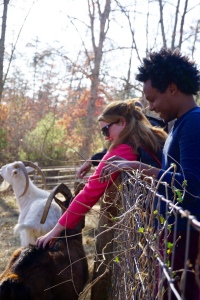 “The current group of AmeriCorps members with Project Power is a really special team,” said Travis. “They all are incredibly positive individuals with a passion for what they do. We think our resources at the farm can help to serve them and bolster our relationship with youth in the community.”
“The current group of AmeriCorps members with Project Power is a really special team,” said Travis. “They all are incredibly positive individuals with a passion for what they do. We think our resources at the farm can help to serve them and bolster our relationship with youth in the community.” Seventeen of the 26 visitors signed up with Travis after the tour in hopes to return to the farm with their children, and four members were also interested in doing environmental education programming on other SAHC properties. The beautiful weather really seemed to compliment a great relationship that is growing between SAHC and Project POWER!
Seventeen of the 26 visitors signed up with Travis after the tour in hopes to return to the farm with their children, and four members were also interested in doing environmental education programming on other SAHC properties. The beautiful weather really seemed to compliment a great relationship that is growing between SAHC and Project POWER!
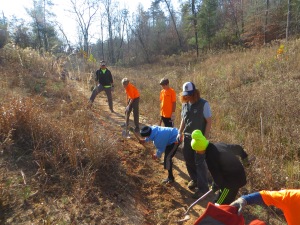 This month, twelve 7th grade boys from the French Broad River Academy (FBRA) volunteered at our Community Farm. We are grateful for assistance from these positive, hard-working students! Service learning is a vital piece of the FBRA curriculum, and they partner with us several times a year to help out with various projects at the Community Farm.
This month, twelve 7th grade boys from the French Broad River Academy (FBRA) volunteered at our Community Farm. We are grateful for assistance from these positive, hard-working students! Service learning is a vital piece of the FBRA curriculum, and they partner with us several times a year to help out with various projects at the Community Farm. Once the digging and grading were mostly done, the boys began to take turns setting logs in place along the wall, and using a post-driver and hammer to drive in rebar to hold the logs. Others helped back-fill the top of the wall with the dirt they had removed earlier.
Once the digging and grading were mostly done, the boys began to take turns setting logs in place along the wall, and using a post-driver and hammer to drive in rebar to hold the logs. Others helped back-fill the top of the wall with the dirt they had removed earlier.





 Land Trust Day Hike
Land Trust Day Hike Community Farm Workshop: Protecting Your Biggest Asset on the Farm, Your Body
Community Farm Workshop: Protecting Your Biggest Asset on the Farm, Your Body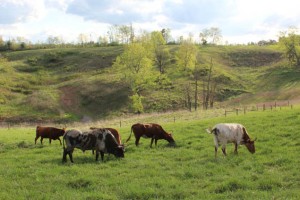 Community Farm Workshop: Pasture Walk – Invasive Plant ID, Control and Removal
Community Farm Workshop: Pasture Walk – Invasive Plant ID, Control and Removal





